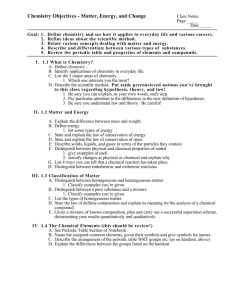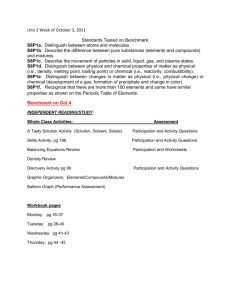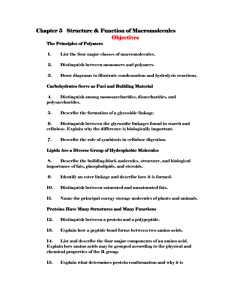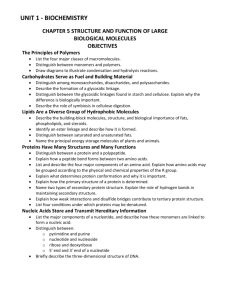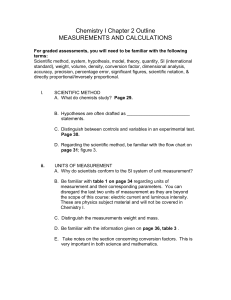2016 Chemistry Concepts Midterm and Final Exam Study Outline
advertisement
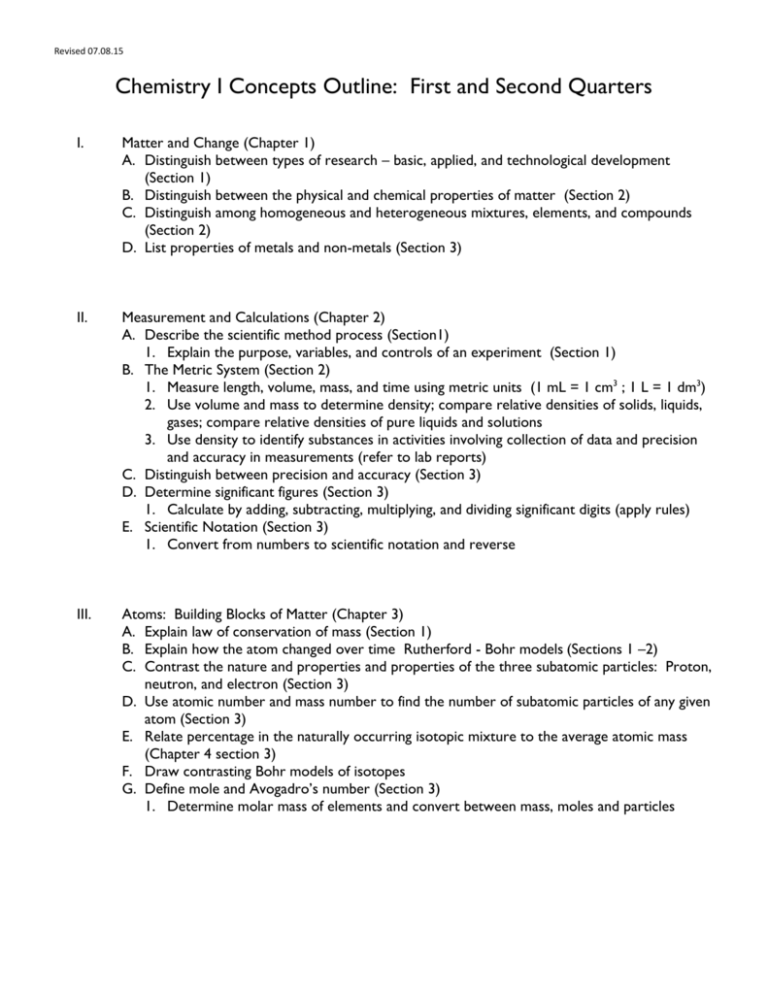
Revised 07.08.15 Chemistry I Concepts Outline: First and Second Quarters I. Matter and Change (Chapter 1) A. Distinguish between types of research – basic, applied, and technological development (Section 1) B. Distinguish between the physical and chemical properties of matter (Section 2) C. Distinguish among homogeneous and heterogeneous mixtures, elements, and compounds (Section 2) D. List properties of metals and non-metals (Section 3) II. Measurement and Calculations (Chapter 2) A. Describe the scientific method process (Section1) 1. Explain the purpose, variables, and controls of an experiment (Section 1) B. The Metric System (Section 2) 1. Measure length, volume, mass, and time using metric units (1 mL = 1 cm3 ; 1 L = 1 dm3) 2. Use volume and mass to determine density; compare relative densities of solids, liquids, gases; compare relative densities of pure liquids and solutions 3. Use density to identify substances in activities involving collection of data and precision and accuracy in measurements (refer to lab reports) C. Distinguish between precision and accuracy (Section 3) D. Determine significant figures (Section 3) 1. Calculate by adding, subtracting, multiplying, and dividing significant digits (apply rules) E. Scientific Notation (Section 3) 1. Convert from numbers to scientific notation and reverse III. Atoms: Building Blocks of Matter (Chapter 3) A. Explain law of conservation of mass (Section 1) B. Explain how the atom changed over time Rutherford - Bohr models (Sections 1 –2) C. Contrast the nature and properties and properties of the three subatomic particles: Proton, neutron, and electron (Section 3) D. Use atomic number and mass number to find the number of subatomic particles of any given atom (Section 3) E. Relate percentage in the naturally occurring isotopic mixture to the average atomic mass (Chapter 4 section 3) F. Draw contrasting Bohr models of isotopes G. Define mole and Avogadro’s number (Section 3) 1. Determine molar mass of elements and convert between mass, moles and particles Revised 07.08.15 IV. Electrons (Chapter 4) A. Write electron configurations in regular order, orbital notation, and noble gas methods B. Compare and contrast levels and sublevels (also their positions on Periodic Table) V. Periodic Table (Chapter 5) A. Describe the organization of the modern Periodic table; distinguish between periods and groups (Sections 1) B. Use the Periodic Table to obtain information about the properties (physical and chemical), ionization energy, and atomic sizes of the elements (Section 2) C. Identify common non-metals, metalloids, and noble gases; identify the representative groups and name them (groups 1,2, 13, 14, 15, 16, 17, 18) (Sections 2) D. Compare periodic trends of atomic radii, ionization energy, and electronegativity (Section 3) VI. Chemical Bonding (Chapter 6) A. Covalent/Molecular Bonds (Section 2) 1. Use the Lewis dot notation, illustrate the covalent bond as the sharing of electrons 2. Name covalent (molecular) compounds using the system of prefixes B. Ionic Bonds (Section 3) 1. List important physical properties of ionic compounds; sum of oxidation numbers = zero 2. Name binary and ternary ionic compounds 3. Name inorganic acids VII. Chemical Formulas and Chemical Compounds (Chapter 7) A. Naming and writing formulas for all types of bonds(Section 1) B. Determine the formula mass (Section 2) C. Use formulas mass to convert between moles and grams (Section 3) D. Calculate the percent composition (Section 3) E. Distinguish among empirical and molecular – definitions and formulas (Section 4) F. Determine the empirical formula from the percent composition (Section 4) G. Determine the molecular formula from the empirical formula (Section 4) Revised 07.08.15 Chemistry I Concepts Outline: Third and Fourth Quarters I. Reactions (Chapter 8) A. Description of Reactions (Section 1) 1. Write word and formula equations 2. Balance chemical equations a. Follows Law of Conservation of Mass B. Types of Reactions (Section 2) 1. Synthesis 2. Decomposition 3. Single displacement 4. Double displacement 5. Combustion II. Stoichiometry (Chapter 9) A. Mole Ratios (Section 1) 1. Determine number of mole from balanced chemical equations. B. Calculations (Section 2) 1. Mole-mole 2. Mole-gram 3. Gram-mole 4. Gram-gram C. Limiting Reactant 1. Calculate stoichiometry problems and determine the limiting reactant, excess reactant, and amount of product produced. III. States of Matter (Chapter 10) A. Intermolecular forces of solid, liquids, and gases (Sections 1-3) B. Phase Diagrams 1. Interpret phase diagrams and determine the triple point (Section 4 – pg. 347) IV. Gases (Chapter 11) A. Identify gas laws (Section 2) 1. Boyle’s 2. Charles’ 3. Ideal gas law (Section 3) B. Apply reaction stoichiometry to solve gas stoichiometry problems. (Section 3) 1. Volume-volume 2. Mass-volume V. Solutions (Chapter 12 & 13) A. Distinguish between an electrolyte and non-electrolyte solution and know examples (Chapter 12 Section 1) B. Effects of temperature on solubility – graph pg. 414 (Chapter 12 Section 2) C. Know types of concentration and be able to solve problems (Chapter 12 Section 3) 1. Molarity 2. Molality D. Explain freezing point depression and boiling point elevation (Chapter 13 Section 1) Revised 07.08.15 VI. Acids and Bases (Chapter 14 & 15) A. Describe the properties of acids and bases (Chapter 14 Section 1 & 2) 1. Arrhenius 2. Bronsted-Lowry B. In terms of ionization, differentiate between strong and weak acids and between strong and weak bases. (Chapter 14 Section 1) C. Complete neutralization reactions and determine the products (Chapter 14 Section 3) D. Calculate pH using the formula and use the pH scale to measure the concentration of the H3O+ ion and OH-1 ion (Chapter 15 Section 1) E. Define titration and determine equivalence point and indicator used during a titration experiment. (Chapter 15 Section 2) VII. Reaction energy (Chapter 16) A. Distinguish between Heat and Temperature and their units (Section 1) B. Calculate heat problems using commons specific heats on pg. 533 (Section1) C. Explain enthalpy change (graphs on pgs. 536-537) 1. Endothermic Reactions 2. Exothermic Reactions VIII. Reaction Rates (Chapter 17) A. Explain the five factors that influence reaction rates on textbook pgs. 568-570 (Section 17.2) IX. Chemical Equilibrium (Chapter 18) A. Explain chemical equilibrium (Section 18.1) X. Oxidation-Reduction Reactions (Chapter 19) A. Define oxidation and reductions and give an example of each reaction. (Section 19.1) XI. Nuclear Chemistry (Chapter 21) A. Describe the different types of radioactive decay and their strength (Section 21.2) 1. Alpha Particle 2. Beta Particle 3. Gamma ray B. Solve half-life problems on pg. 689 (Section 21.2) C. Explain benefits of nuclear radiation on textbook pg. 695 (Section 21.3) D. Distinguish between nuclear fission and nuclear fusion (21.4) XII. Organic Chemistry (Chapter 22) A. Determine the number of bond that carbon, hydrogen, and oxygen can make. B. Distinguish among structures of alkanes, alkenes, and alkynes (Section 22.2) XIII. Biological Chemistry (Chapter 23) A. Distinguish between structural characteristics of hydrocarbons, carbohydrates, nucleic acids, and proteins (Section 23.1)

